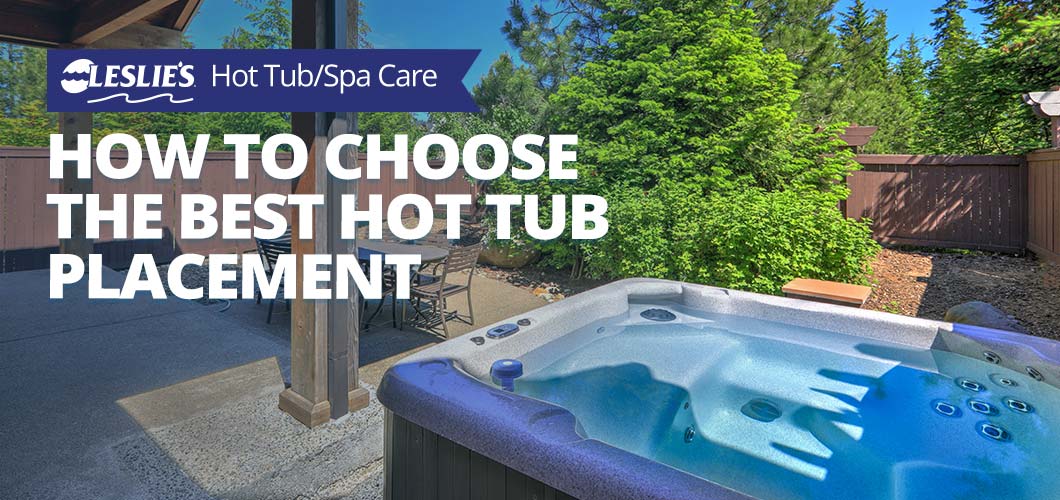
How to Choose the Best Hot Tub Placement
A portable hot tub can go just about anywhere – patio, gazebo, backyard, indoors, or anywhere else you want. But where’s the best place to put it? Before choosing a location for your new spa or hot tub, it's important to consider a few key points. These tips will help you determine the best hot tub placement options for your home.
Intended Use

Are you planning to use the hot tub for quiet relaxation and stress relief? Or will its primary purpose be for entertainment and enjoyment during social events and parties at your home? Will you using the hot tub for treatment of chronic pain? Or will you be spending romantic evenings in the company of a loved one? The intended use of your new hot tub should play a big role in its placement.
If you’re wanting a more private, relaxing environment, you may want to install it behind a privacy barrier, on an enclosed/screened patio, or beneath a pergola with floaty curtains. On the other hand, if you want to enjoy scenic landscape views or prefer a more inviting setting, you may want to place it somewhere a little more open. If you plan to use it during the day, it’s important to consider shade. Likewise, frequent nighttime use will require some type of lighting near the hot tub and walkway for safety reasons.
BONUS TIP: If you like to entertain guests, but also want a bit of privacy around your hot tub, consider a flexible placement option. A pergola with decorative curtains can be tied back for a more inviting aesthetic, or pull the curtains closed for a quiet, relaxing soak on your own.
Proximity

How close is the hot tub to your home? A hot tub placed in the farthest back corner of your yard is less enticing than one that’s just outside the back door. This is especially true during the cold winter months. Another thing to consider is the location of the water spigot and electrical access point. If it’s not close to the hot tub, you may need to hire a plumber or electrician to bring the access closer. Depending on your current electrical setup and the type of hot tub you buy, you may need to bring in an electrician, regardless. But having to move the connection more than a few feet will only add to the final bill.
Also consider how close the hot tub placement will be to walls, fences, and other solid obstacles. In the event that you want to install a spa cover lift or need to access to the spa components for repairs, you'll need enough room to do so. At a minimum, you'll at least want enough space maneuver around and secure all the spa cover straps easily. This proximity tip also ties into the "future maintenance" section below. In most cases, hot tubs do best with a bit of extra breathing room on at least three sides, if not all the way around. The manufacturer or dealer you purchase the hot tub from may have recommendations. It never hurts to ask!
Delivery and Installation

Portable spas and hot tubs are large, heavy and cumbersome to move around. That is, of course, unless you have an inflatable hot tub. In that case, skip ahead to the next section.
If you bought your new hot tub from a local dealer or showroom, a delivery crew will likely help set the hot tub in its new location. There needs to be a clear, wide path from the point of delivery to the desired placement area. Any obstructions, obstacles, or narrow passages will make moving the hot tub considerably more difficult.
If the company has to move the spa or hot tub by crane, you’ll have to leave room for the crane to maneuver. Be aware that you may need to temporarily remove fence panels, gates, or deck railings to make the process go smoothly.
BONUS TIP: When you go to purchase your new hot tub, bring some photos of the desired location and the area that leads up to it. Your salesman should be able to address any placement or delivery concerns before you complete your purchase.
Support

Hot tubs weigh well over a ton (or two!) when full of water and people. Wherever you decide is the best placement your hot tub, it’s important to make sure there’s enough support to hold the extra weight. The area should be flat, level, and resistant to sinking, shifting, or sagging. Most portable hot tubs are installed at ground level on a concrete slab. Alternatively, you can also use materials like gravel, bricks, or stone pavers to prevent the hot tub from settling down into soft soil.
If you intend to place the hot tub somewhere higher, like on top of a deck, you'll need to add reinforcements underneath. Wooden decks are likely to warp and/or collapse without sufficient beams or braces to support added weight of the hot tub.
Future Maintenance

Before your new hot tub arrives, double-check the dimensions. Will your chosen hot tub placement fit well in your chosen spot, and will it have some amount of working space around it? In the event of a repair, you’ll want to have easy access to the spa cabinet to reach the equipment, plumbing, and electrical components. Always plan for the worst possible scenario, and make sure you have the room to accommodate.
If installing the hot tub on or near wood, take measures to seal the wood and keep it as water resistant as possible. Splashes and frequent water exposure spell disaster for untreated wood.
Speaking of water, drainage is also something to take into consideration. In addition to your regular hot tub maintenance routine, you'll need to drain a portable hot tub every three to four months. All drainage should be able to flow away from your home and hot tub. The same goes for storm planning and avoiding low-lying areas. Will excess rain water drain away nicely, or will it collect and pool around your hot tub area? If the water lingers, you'll eventually face problems with rotting wooden cabinets, electrical shortages, moldy insulation, and other issues caused by the extra moisture.